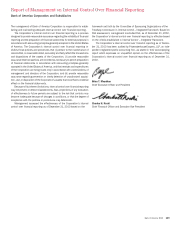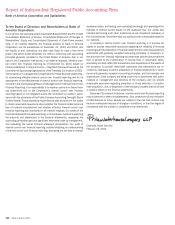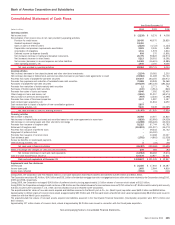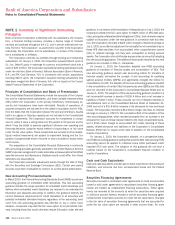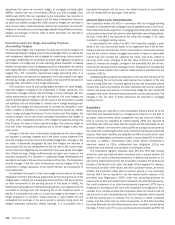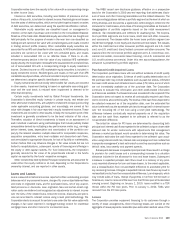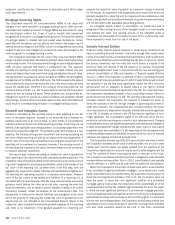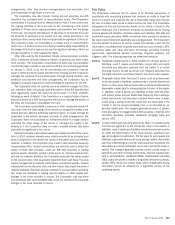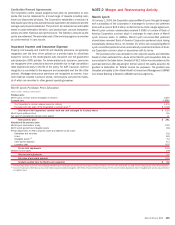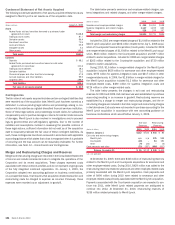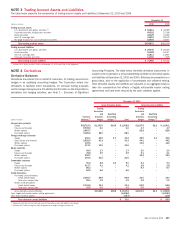Bank of America 2010 Annual Report Download - page 151
Download and view the complete annual report
Please find page 151 of the 2010 Bank of America annual report below. You can navigate through the pages in the report by either clicking on the pages listed below, or by using the keyword search tool below to find specific information within the annual report.Corporation writes down the security to fair value with a corresponding charge
to other income (loss).
Interest on debt securities, including amortization of premiums and ac-
cretion of discounts, is included in interest income. Realized gains and losses
from the sales of debt securities, which are included in gains (losses) on sales
of debt securities, are determined using the specific identification method.
Marketable equity securities are classified based on management’s
intention on the date of purchase and recorded on the Consolidated Balance
Sheet as of the trade date. Marketable equity securities that are bought and
held principally for the purpose of resale in the near term are classified as
trading and are carried at fair value with unrealized gains and losses included
in trading account profits (losses). Other marketable equity securities are
accounted for as AFS and classified in other assets. All AFS marketable equity
securities are carried at fair value with net unrealized gains and losses
included in accumulated OCI on an after-tax basis. If there is an oth-
er-than-temporary decline in the fair value of any individual AFS marketable
equity security, the Corporation reclassifies the associated net unrealized loss
out of accumulated OCI with a corresponding charge to equity investment
income. Dividend income on AFS marketable equity securities is included in
equity investment income. Realized gains and losses on the sale of all AFS
marketable equity securities, which are recorded in equity investment income,
are determined using the specific identification method.
Equity investments without readily determinable fair values are recorded
in other assets. Impairment testing is based on applicable accounting guid-
ance and the cost basis is reduced when impairment is deemed to be
other-than-temporary.
Certain equity investments held by Global Principal Investments, the
Corporation’s diversified equity investor in private equity, real estate and
other alternative investments, are subject to investment company accounting
under applicable accounting guidance, and accordingly, are carried at fair
value with changes in fair value reported in equity investment income. These
investments are included in other assets. Initially, the transaction price of the
investment is generally considered to be the best indicator of fair value.
Thereafter, valuation of direct investments is based on an assessment of
each individual investment using methodologies that include publicly traded
comparables derived by multiplying a key performance metric (e.g., earnings
before interest, taxes, depreciation and amortization) of the portfolio com-
pany by the relevant valuation multiple observed for comparable companies,
acquisition comparables, entry level multiples and discounted cash flows,
and are subject to appropriate discounts for lack of liquidity or marketability.
Certain factors that may influence changes in fair value include but are not
limited to recapitalizations, subsequent rounds of financing and offerings in
the equity or debt capital markets. For fund investments, the Corporation
generally records the fair value of its proportionate interest in the fund’s
capital as reported by the funds’ respective managers.
Other investments held by Global Principal Investments are accounted for
under either the equity method or at cost, depending on the Corporation’s
ownership interest, and are reported in other assets.
Loans and Leases
Loans measured at historical cost are reported at their outstanding principal
balances net of any unearned income, charge-offs, unamortized deferred fees
and costs on originated loans, and for purchased loans, net of any unamor-
tized premiums or discounts. Loan origination fees and certain direct origi-
nation costs are deferred and recognized as adjustments to interest income
over the lives of the related loans. Unearned income, discounts and premi-
ums are amortized to interest income using a level yield methodology. The
Corporation elects to account for certain loans under the fair value option with
changes in fair value reported in mortgage banking income for residential
mortgage loans and other income for commercial loans.
The FASB issued new disclosure guidance, effective on a prospective
basis for the Corporation’s 2010 year-end reporting, that addresses disclo-
sure of loans and other financing receivables and the related allowance. The
new accounting guidance defines a portfolio segment as the level at which an
entity develops and documents a systematic methodology to determine the
allowance for credit losses, and a class of financing receivables as the level of
disaggregation of portfolio segments based on the initial measurement
attribute, risk characteristics and methods for assessing risk. The Corpora-
tion’s portfolio segments are home loans, credit card and other consumer,
and commercial. The classes within the home loans portfolio segment are
residential mortgage, home equity and discontinued real estate. The classes
within the credit card and other consumer portfolio segment are U.S. credit
card, non-U.S. credit card, direct/indirect consumer and other consumer. The
classes within the commercial portfolio segment are U.S. commercial, com-
mercial real estate, commercial lease financing, non-U.S. commercial and
U.S. small business commercial. Under this new accounting guidance, the
allowance is presented by portfolio segment.
Purchased Credit-impaired Loans
The Corporation purchases loans with and without evidence of credit quality
deterioration since origination. Evidence of credit quality deterioration as of
the purchase date may include statistics such as past due status, refreshed
borrower credit scores and refreshed loan-to-value (LTV) ratios, some of which
are not immediately available as of the purchase date. The Corporation
continues to evaluate this information and other credit-related information
as it becomes available. Purchased loans are considered to be impaired if the
Corporation does not expect to receive all contractually required cash flows
due to concerns about credit quality. The excess of the cash flows expected to
be collected measured as of the acquisition date, over the estimated fair
value is referred to as the accretable yield and is recognized in interest income
over the remaining life of the loan using a level yield methodology. The
difference between contractually required payments as of the acquisition
date and the cash flows expected to be collected is referred to as the
nonaccretable difference.
The initial fair values for PCI loans are determined by discounting both
principal and interest cash flows expected to be collected using an observable
discount rate for similar instruments with adjustments that management
believes a market participant would consider in determining fair value. The
Corporation estimates the cash flows expected to be collected upon acqui-
sition using internal credit risk, interest rate and prepayment risk models that
incorporate management’s best estimate of current key assumptions such as
default rates, loss severity and payment speeds.
Subsequent decreases to expected principal cash flows result in a charge
to provision for credit losses and a corresponding increase to a valuation
allowance included in the allowance for loan and lease losses. Subsequent
increases in expected principal cash flows result in a recovery of any previ-
ously recorded allowance for loan and lease losses, to the extent applicable,
and a reclassification from nonaccretable difference to accretable yield for
any remaining increase. Changes in expected interest cash flows may result in
reclassifications to/from the nonaccretable difference. Loan disposals, which
may include sales of loans, receipt of payments in full from the borrower or
foreclosure, result in removal of the loan from the PCI loan pool at its allocated
carrying amount. Beginning on January 1, 2010, loans modified in a TDR
remain within the PCI loan pools. Prior to January 1, 2010, TDRs were
removed from the PCI loan pools.
Leases
The Corporation provides equipment financing to its customers through a
variety of lease arrangements. Direct financing leases are carried at the
aggregate of lease payments receivable plus estimated residual value of the
Bank of America 2010 149


